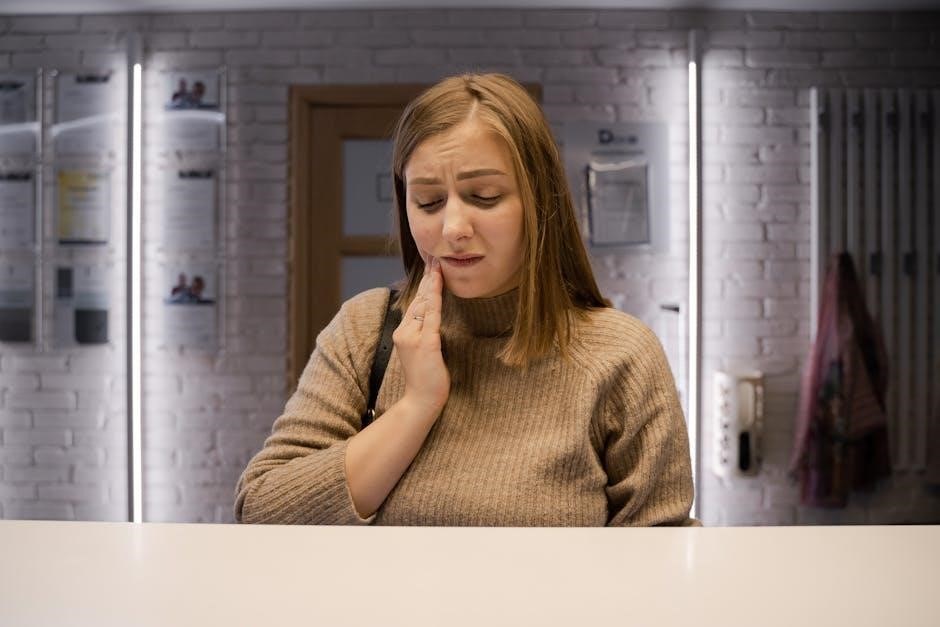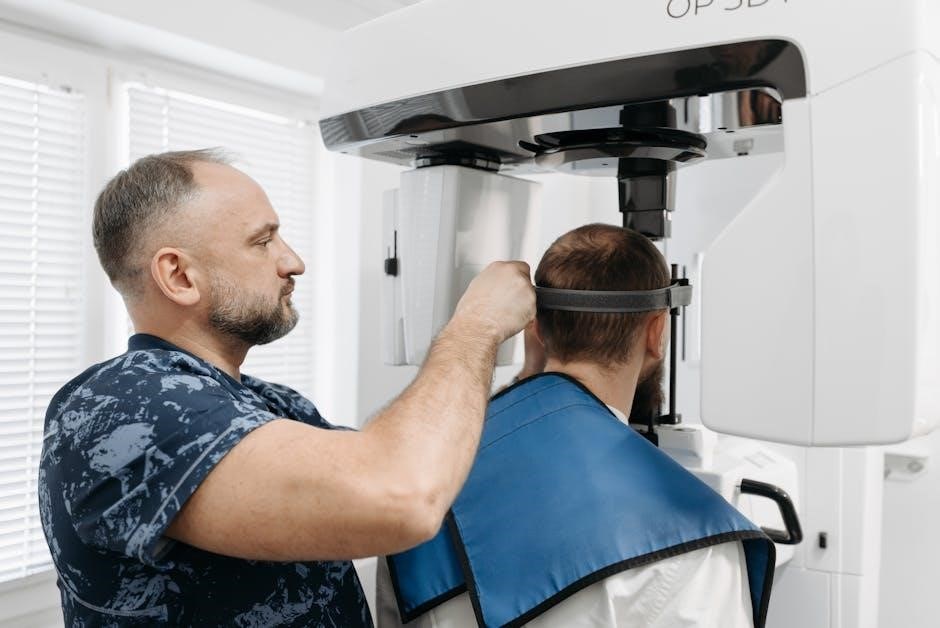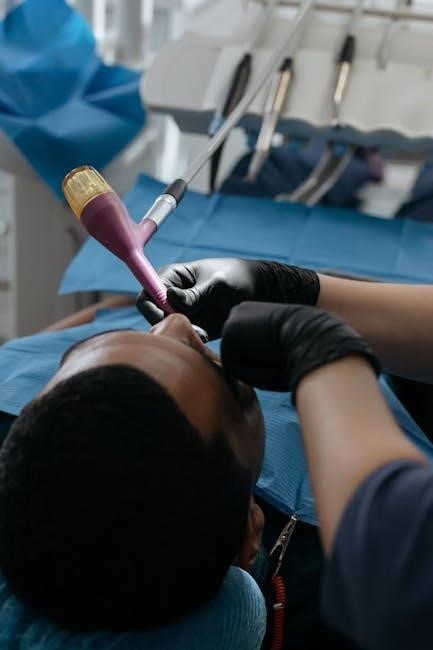OSHA compliance is crucial for dental offices to ensure a safe working environment and protect patient and employee health․ An OSHA manual is a required document that must be up-to-date and customized specifically to your dental office location․ It outlines policies, procedures, and standards to prevent hazards and ensure adherence to federal regulations․ Non-compliance can lead to legal penalties and jeopardize workplace safety․ Regular updates and staff training are essential to maintain compliance and address emerging challenges in dental practices․
1․1 Importance of OSHA Compliance in Dental Practices
OSHA compliance is vital for dental practices to safeguard employees and patients from occupational hazards․ Dental staff face risks like bloodborne pathogens, hazardous chemicals, and physical strains․ Adhering to OSHA standards ensures a safer work environment, reduces legal penalties, and promotes a culture of safety․ Compliance also mitigates workplace injuries and illnesses, protecting both staff and patients while maintaining trust and operational integrity․
1․2 Overview of Key OSHA Standards for Dental Offices
Dental offices must comply with OSHA standards addressing bloodborne pathogens, hazard communication, and record-keeping․ The Bloodborne Pathogens Standard requires an exposure control plan, while the Hazard Communication Standard mandates proper chemical labeling and safety data sheets․ Additional standards cover fire safety, personal protective equipment, and reporting work-related injuries․ Adherence to these standards ensures a safe environment and protects employees from occupational hazards․

Bloodborne Pathogens Standard in Dental Offices
The Bloodborne Pathogens Standard protects dental staff from exposure to bloodborne diseases like HIV and Hepatitis; It requires an exposure control plan, PPE, and proper training․
2․1 Understanding the Exposure Control Plan
The Exposure Control Plan (ECP) is a critical component of OSHA compliance for dental offices․ It outlines procedures to minimize occupational exposure to bloodborne pathogens․ The plan must be customized to the dental office, updated annually, and made accessible to all employees․ It includes methods for exposure control, personal protective equipment (PPE) usage, and post-exposure protocols․ Regular training ensures staff comprehension and adherence to the ECP․
2․2 Hepatitis B Vaccination Policy and Requirements
The Hepatitis B vaccination policy requires dental offices to offer the vaccine to employees at risk of exposure to bloodborne pathogens․ The vaccination must be provided at no cost within 10 days of employment, unless the employee declines in writing․ Employers must maintain records of vaccination dates and any employee declinations․ This policy ensures compliance with OSHA standards to protect worker health and safety․

Hazard Communication Standard (HCS) in Dentistry
The Hazard Communication Standard ensures dental offices safely handle hazardous chemicals․ Proper labeling, storage, and Safety Data Sheet (SDS) management are critical for employee safety and compliance․
3․1 Safety Data Sheets (SDS) for Dental Materials
Safety Data Sheets (SDS) are essential for identifying hazards in dental materials․ Each SDS provides detailed information on safe handling, storage, and emergency procedures․ Dental offices must maintain an organized SDS database, ensuring easy access for all staff․ Regular updates and training on SDS interpretation are crucial to prevent chemical exposure risks and maintain OSHA compliance․
3․2 Proper Labeling and Storage of Chemicals
Proper labeling and storage of chemicals are critical for dental office safety․ Use clear, legible labels with hazard information and warning symbols․ Store chemicals in designated areas, away from incompatible substances to prevent reactions․ Follow manufacturer instructions and ensure secondary containers match original labels․ Regular inspections help maintain order and prevent hazards, ensuring OSHA compliance and a safer workplace environment․ This practice minimizes risks and enhances overall safety standards․
Record-Keeping Requirements for OSHA Compliance
Accurate record-keeping is essential for OSHA compliance․ Maintain injury logs, employee medical records, and incident reports․ Ensure all documents are up-to-date and accessible for inspections to avoid violations and ensure workplace safety․
4․1 Maintaining Employee Medical Records
Maintaining accurate and confidential employee medical records is critical for OSHA compliance․ These records must include vaccination status, medical exams, and work-related injury treatments․ Ensure all records are stored securely, with access limited to authorized personnel․ Regular audits should be conducted to verify completeness and compliance with OSHA standards, safeguarding employee health and legal requirements․
4․2 Reporting Work-Related Injuries and Illnesses
Reporting work-related injuries and illnesses promptly is essential for OSHA compliance․ Employers must document incidents using OSHA Form 300 and notify authorities if severe․ Accurate records help track incidents, prevent future occurrences, and ensure legal adherence․ Regular training for staff on reporting procedures is vital to maintain a safe workplace and comply with federal regulations․

Emergency Preparedness and Response
Emergency preparedness ensures dental offices can respond to crises effectively․ Develop a clear action plan, conduct regular drills, and train staff to ensure safety for all employees during emergencies․
5․1 Developing an Emergency Action Plan
A comprehensive emergency action plan is essential for dental offices to ensure safety during crises․ It should include evacuation routes, emergency contact details, and communication methods․ Regular drills and updates are necessary to maintain preparedness․ The plan must address fire, chemical spills, and medical emergencies, ensuring staff know their roles and responsibilities․ Proper training and accessibility of emergency equipment, like fire extinguishers and first aid kits, are critical for effective response․
5․2 Managing Chemical Spills and Exposures
Proper management of chemical spills and exposures is critical in dental offices to minimize risks․ Immediate containment, cleanup, and neutralization are essential․ Use Safety Data Sheets (SDS) for specific handling and cleanup procedures․ Ensure staff wear appropriate PPE, including gloves and goggles, during incidents․ Train employees on spill response protocols and emergency procedures․ Maintain a spill response plan and document all incidents for review and compliance․
Annual OSHA Training for Dental Office Staff
Annual OSHA training is mandatory for all dental staff․ It covers hazard identification, PPE use, exposure control, and emergency procedures; Ensure active participation and documentation for compliance․
6․1 Required Topics for OSHA Training
OSHA training for dental staff must cover essential topics like bloodborne pathogens, hazard communication, fire safety, emergency procedures, and proper use of PPE․ Understanding these topics ensures compliance and a safer workplace․ Regular updates and staff engagement are crucial for maintaining a safe environment and adhering to federal regulations․ Proper documentation of training sessions is also required․
6․2 Ensuring Compliance with Training Requirements
Annual OSHA training is mandatory for all dental office employees․ Ensure compliance by documenting attendance and maintaining records․ Regularly review and update training materials to align with current regulations․ Provide clear instructions and ensure all staff participate․ Follow-up sessions and refreshers can reinforce compliance․ Proper documentation and consistent enforcement are key to maintaining a safe and compliant work environment․
Fire Safety and Prevention in Dental Offices
Fire safety is critical in dental offices․ Proper use of fire extinguishers, maintaining emergency exits, and regular drills ensure preparedness and compliance with OSHA standards․

7․1 Proper Use of Fire Extinguishers
Proper use of fire extinguishers is essential for dental office safety․ Staff should be trained to use the PASS method: Pull the pin, Aim the nozzle, Squeeze the handle, and Sweep the area․ Only trained employees should attempt to extinguish fires․ If the fire is large or spreading, evacuate immediately․ Regular inspections and maintenance of extinguishers ensure functionality․ OSHA requires annual training on fire safety protocols․
7․2 Maintaining Emergency Exits and Alarms
Maintaining emergency exits and alarms is critical for dental office safety․ Ensure all emergency exits are unobstructed, clearly marked, and accessible at all times․ Regular inspections of exit signs, emergency lighting, and alarm systems are required․ Test fire alarms monthly and document results․ Train staff on evacuation routes and procedures․ Keep emergency exit pathways clear and properly lit to ensure swift evacuation during emergencies․ Compliance ensures safety and avoids violations․

Personal Protective Equipment (PPE) in Dentistry
Personal Protective Equipment (PPE) is essential in dentistry to safeguard against pathogens and chemicals․ Gloves, masks, and eye protection are critical for preventing exposure during procedures․ Proper use and maintenance ensure compliance and staff safety․
8․1 Selection and Use of PPE for Dental Procedures
Selecting the right PPE for dental procedures is vital to ensure staff safety․ Gloves prevent skin contact with pathogens, while masks and eye protection shield against airborne contaminants․ Proper fitting and donning techniques must be followed․ PPE should be chosen based on the level of exposure risk, from routine exams to complex surgeries․ Training on correct use is essential to maintain effectiveness and compliance with OSHA standards․
8․2 Proper Disposal of Contaminated PPE
Contaminated PPE must be disposed of in designated biohazard containers to prevent exposure risks․ Remove PPE carefully to avoid cross-contamination, and wash hands immediately after disposal․ Never reuse or recycle contaminated items․ Ensure all staff are trained on proper disposal protocols to maintain compliance with OSHA and CDC guidelines․ Regularly inspect disposal containers and replace them when full to uphold workplace safety standards․
Patient and Employee Safety Protocols

Patient and employee safety protocols are essential for minimizing risks in dental offices․ Implement infection control measures, proper PPE use, and emergency preparedness to ensure a safe environment․ Regular training and compliance with OSHA standards help protect both patients and staff from potential hazards․
9․1 Infection Control Measures
Infection control measures are critical for preventing the spread of diseases in dental settings․ Implement proper sterilization protocols, use personal protective equipment (PPE), and ensure safe handling of contaminated materials․ Adherence to OSHA standards and regular training help maintain a hygienic environment, protecting both patients and staff from infectious agents․ Compliance with these measures is essential for ensuring safety and preventing health risks․

9․2 Managing Workplace Violence
Managing workplace violence is essential for maintaining a safe dental office environment․ Develop policies to address potential conflicts, train staff to recognize and respond to aggressive behavior, and establish clear reporting procedures․ Ensure all incidents are documented and addressed promptly․ Regular training on de-escalation techniques and emergency response plans can help minimize risks and protect employees and patients from harm․

OSHA Inspections and Violations
OSHA inspections in dental offices ensure compliance with safety standards․ Regular, unannounced inspections check for violations, such as incomplete records or unsafe practices․ Non-compliance can result in fines and legal action, emphasizing the importance of preparation and adherence to regulations to protect employee and patient safety and avoid penalties․
10․1 Preparing for an OSHA Inspection
Preparing for an OSHA inspection involves ensuring all documentation, such as injury records and safety training logs, is up-to-date and readily available․ Conduct regular internal audits to identify and address potential hazards, ensuring compliance with standards like Bloodborne Pathogens and Hazard Communication․ Train staff on emergency procedures and maintain a clean, organized workspace․ Designate a compliance officer to guide the inspection process smoothly, minimizing violations and penalties by demonstrating a proactive approach to workplace safety․
10․2 Understanding and Addressing OSHA Violations
Understanding OSHA violations requires reviewing inspection citations and addressing root causes․ Corrective actions include implementing safety measures, retraining staff, and updating policies․ Violations must be resolved within specified timelines to avoid penalties․ Maintaining open communication with OSHA and documenting compliance efforts ensures transparency and cooperation, demonstrating a commitment to workplace safety and preventing future violations through proactive adjustments to office practices and procedures․

FAQs and Common Mistakes
FAQs often address training requirements and record-keeping, while common mistakes include outdated manuals and incomplete staff training․ Ensuring compliance requires regular updates and adherence to OSHA standards․
11․1 Frequently Asked Questions About OSHA Compliance
Common questions include how often OSHA training is required and who must attend․ Annual training is mandatory for all dental staff exposed to hazards․ Other FAQs address record-keeping, injury reporting, and the importance of an updated OSHA manual․ Understanding these helps ensure compliance and workplace safety, preventing penalties and fostering a secure environment for both patients and employees․
11․2 Avoiding Common OSHA Violations in Dental Offices
Common violations include outdated OSHA manuals, inadequate training, and improper handling of bloodborne pathogens․ To avoid these, ensure staff receives annual training, maintain updated records, and regularly review safety protocols․ Proper disposal of contaminated PPE and accurate injury reporting are also critical․ Compliance checklists and regular audits can help identify and correct issues before they lead to violations and penalties․

Leave a Reply